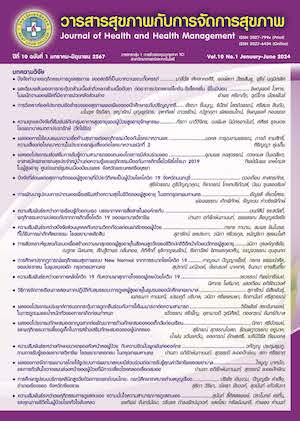Acute Effect of Activating Trunk and Thigh Muscles on Pain and Flexion-Relaxation Phenomenon in Office Workers with Low Back Pain
Keywords:
Flexion-relaxation phenomenon, Muscles activation, Low back pain, Sitting officersAbstract
The purpose of this research was to compare the effects of activating muscle in the sample group of 30 people with lower back pain caused by sitting for work using different programs. Testing pain flexibility and flexion-relaxation phenomenon (FRP) before and after giving the activating muscle program. Data were collected using a pain questionnaire, sit and reach test, and electromyography (EMG) of back muscles to determine the FRP. The FRP is an indication of the ability to flexion-relaxation of two back muscles the erector spinae muscle and the multifidus muscle. Data before and after the experiment were analyzed using a one-way analysis of variance (ANOVA). Pairwise comparisons were made using the LSD method, and within-group data were compared using the t-test.
The results showed that all three groups had reduced pain and increased flexibility after the experiment. The control group and the thigh muscle activation group had significantly increased flexibility. The FRP decreased significantly between the control group and the thigh muscle activation group, and between the trunk muscle activation group and the thigh muscle activation group. Only the trunk muscle activation group showed a decrease in the FRP in the multifidus muscle, unlike the other groups. Therefore, in people who suffer from pain after sitting at work, it is important to increase the ability of the multifidus muscle to work to increase back stability by activating the trunk muscles and to increase muscle flexibility by activating both the trunk muscles and the thigh muscles. Modifying muscle function during sitting can help prevent back pain.
References
วสุวัฒน์ กิติสมประยูรกุล, จักรกริช กล้าผจญ, และอภิชนา โฆวินทะ. (2547). แบบประเมินความเจ็บปวด Shot-form McGill Pain Questionnaire ฉบับภาษาไทย. เวชศาสตร์ฟื้นฟูสาร, 14(3), 83-92.
Beneciuk, J. M., Bishop, M. D., Fritz, J. M., Robinson, M. E., Asal, N. R., Nisenzon, A. N., & George, S.Z. (2013). The STarT back screening tool and individual psychological measures: evaluation of prognostic capabilities for low back pain clinical outcomes in outpatient physical therapy settings. Physical therapy, 93(3), 321-333.
Borman, N. P., Trudelle-Jackson, E., & Smith, S. S. (2011). Effect of stretch positions on hamstring muscle length, lumbar flexion range of motion, and lumbar curvature in healthy adults. Physiotherapy theory and practice, 27(2), 146-154.
Chatchawan, U., Jupamatangb, U., Chanchitc, S., Puntumetakul, R., Donpunha, W., & Yamauchi, J. (2015). Immediate effects of dynamic sitting exercise on the lower back mobility of sedentary young adults. Journal of physical therapy science, 27(11), 3359-3363.
Colloca, C. J., & Hinrichs, R. N. (2005). The biomechanical and clinical significance of the lumbar erector spinae flexion-relaxation phenomenon: a review of literature. Journal of manipulative and physiological therapeutics, 28(8), 623-631.
Floyd, W. F., & Silver, P. (1951). Function of erector spinae on flexion of the trunk. American Journal of Physical Medicine & Rehabilitation, 30(3), 180.
Fryer, J. C., Quon, J. A., & Smith, F. W. (2010). Magnetic resonance imaging and stadiometric assessment of the lumbar discs after sitting and chair-care decompression exercise: a pilot study. The Spine Journal, 10(4), 297-305.
Ippersiel, P., Preuss, R., Fillion, A., Jean-Louis, J., Woodrow, R., Zhang, Q., & Robbins, S. M. (2021). Inter-joint coordination and the flexion-relaxation phenomenon among adults with low back pain during bending. Gait & Posture, 85(1), 164-170.
Keawduangdee, P., Puntumetakul, R., Swangnetr, M., Laohasiriwong, W., Settheetham, D., Yamauchi, J., & Boucaut, R. (2015). Prevalence of low back pain and associated factors among farmers during the rice transplanting process. Journal of physical therapy science, 27(7), 2239-2245.
Kim, C. H., Gwak, G. T., & Kwon, O. Y. (2017). Comparison of the flexion-relaxation ratio of the hamstring muscle and lumbopelvic kinematics during forward bending in subjects with different hamstring muscle flexibility. Physical Therapy Korea, 24(4), 1-10.
Laird, R. A., Keating, J. L., & Kent, P. (2018). Subgroups of lumbo-pelvic flexion kinematics are present in people with and without persistent low back pain. BMC musculoskeletal disorders, 19(1), 1-13.
Lee, I., Sim, S., & Jin, S. (2021). Hamstring stretching significantly changes the sitting biomechanics. International Journal of Industrial Ergonomics, 84, 103163. doi:10.1016/j.ergon.2021.103163
Myers, T. W. (2009). Anatomy trains: myofascial meridians for manual and movement therapists. China: Elsevier Health Sciences.
Olivier, N., Thevenon, A., Berthoin, S., & Prieur, F. (2013). An exercise therapy program can increase oxygenation and blood volume of the erector spinae muscle during exercise in chronic low back pain patients. Archives of physical medicine and rehabilitation, 94(3), 536-542.
Pillai, D., & Haral, P. (2018). Prevalence of low back pain in sitting vs standing postures in working professionals in the age group of 30-60. International Journal of Health Sciences & Research, 8(10), 131-137.
Downloads
Published
How to Cite
Issue
Section
License
Copyright (c) 2024 Journal of health and health management

This work is licensed under a Creative Commons Attribution-NonCommercial-NoDerivatives 4.0 International License.




